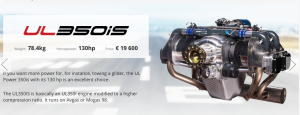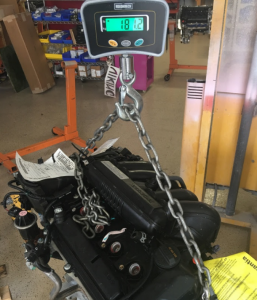Here are some of our thoughts on engines:
- Fuel injected engine – I prefer not having a carburetor. I don’t want to have to worry about carburetor icing. I only rent the fuel injected Cessna’s at my local airport. One of the best things about building an experimental airplane is that you can affordably use current technology that is arguably safer.
- Digital engine controls – Like every car has. Why manually adjust the fuel/air mixture ratio when a engine computer can do that better than you can?
- HP Range – common choices are 80-130HP engines. Reducing weight tends to help performance as much as power.
- Ability to burn standard automotive gasoline
- Weight – It seems like the Searey will work best with an installed engine that weighs less than 200lbs when you take all fluids, mounting hardware, and cooling equipment into account.
- We don’t want to be test pilots. It is best to pick an option that has other Searey’s already flying.
Potential engine options:
- ULPower 350is – 130HP, traditional aircraft style engine, air cooled, direct drive engine.
Pros: low weight, high horsepower, priced in the middle of the alternatives. Has very good engine data published online. Engine has special cooling features to avoid overheating like larger fins and cylinder oil bathing.
Cons: So far one Searey flying that I know of but the owner likes it. Propeller RPM requires special prop considerations. Airflow on an air cooled pusher engine needs to be designed correctly to avoid overheating.
http://ulpower.com/engines/ul350is

- Aeromomentum AM15 – 117 HP Suzuki G15A automotive conversion. (This is what we ended up choosing)
Aeromomentum has sold 100+ engines, has 3 Aventuras flying and a bunch of airboat users.
A couple people are buying them for Searey’s.
They provide a mount that will attach directly to the 914 root tube.
Slant engine dry, with all reservoirs, no radiator, sensors but no wiring harness – weighs 171.5 lbs
Harness is 2 lbs. ECU is 12 oz, big radiator: 4.8 lbs
That comes to 180ish dry all inclusive +1 gal of coolant, 1 gal of oil
Fully installed: The AM15 should be 20-25 lbs heavier than the lightest 912 and ~15 lbs heavier than a 914.
Cost is less than half of the ULPower 350is which is always nice. - Viking 130 – 130HP, Honda Fit automotive conversion. Liquid cooled, reduction gear drive.
The 130 model is new because Honda updated the Fit engine in 2015. I think it got heavier and the horsepower increased by 20.
Pros: lowest cost, Honda reliability and low cost parts/maintenance. There are multiple Searey’s flying with the Viking 110hp and one that I know of flying with the Viking 130hp engine.
Cons: Heaviest engine choice, perhaps too heavy for the Searey? Engine performance data published is from Honda, we would like to see actual data from this engine/ecu/reduction gear implementation. Viking claims Gasoline Direct Injection as a benefit but it is not clear what the benefit for airplanes is. GDI gives better mileage at idle which I think matters more for cars than airplanes. It makes sense that if Honda decided to use GDI for cars then Viking must use it for airplanes and would claim that it offers an advantage but what exactly is the GDI advantage? The Honda has the lowest initial cost and parts are inexpensive.
http://www.vikingaircraftengines.com - Rotax 912is – 100HP, FADEC, Fuel injection, reduction gear drive
Pros: Fuel injected version of the Rotax 912 that many Searey’s use. I think a few Searey’s are using the 912is (Single digits still?)
Cons: $22K price, liquid cooled. People wonder whether the extra cost and weight justify better MPG.
http://www.flightevolution.com/en/The-Engine - Rotax 915is – Probably won’t be in production soon enough for us to use. 135HP, turbo intercooler, FADEC, Fuel injection reduction gear drive. This engine might be too powerful for the existing Searey airframe.
Coming in 2H 2017. Am guessing this will be $40K+ but have also heard lower.
http://www.brp.com/en-us/company/news/rotax-915-brp-unveils-new-turbocharged-rotax-aircraft-engine.
Weight information.
Here are the published dry weights and claimed operating weights.
…………………………Dry…….Claimed Operating
Rotax 914……………141 lbs…….173 lbs
Rotax 912S/ULS……125 lbs…….141 lbs
ULPower 350is……..145 lbs…….173 lbs
Viking 130 GDI……..178 lbs…….224 lbs (from wikipedia)
I recently saw that the 2015 1.5L Honda Fit Engine block is 181.2 lbs stock before Viking modifications.
Here’s an example of what makes up the 28 pound difference between dry weight and claimed operating weight with a ULPower 350is.
Ignition coil & wiring leads – 6.6lbs
ECU computer and wiring – 3.5 lbs
Exhaust, bolts, springs, seals – 8 lbs
Electric fuel pump – 1.6 lbs
Fuel filters – 0.4 lbs
Oil/air separator and hoses – 1.5 lbs
Rectifier regulator – 0.2 lbs
Rubber engine mounts – 0.7 lbs
Oil cooler – 2.2 lbs
2.5 liters of engine oil – 4.9 lbs
Some engines would also have a radiator and antifreeze.
Special mounting brackets and airflow scoops might also be added.


